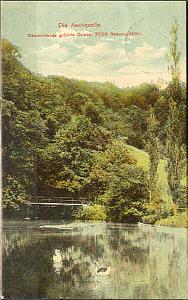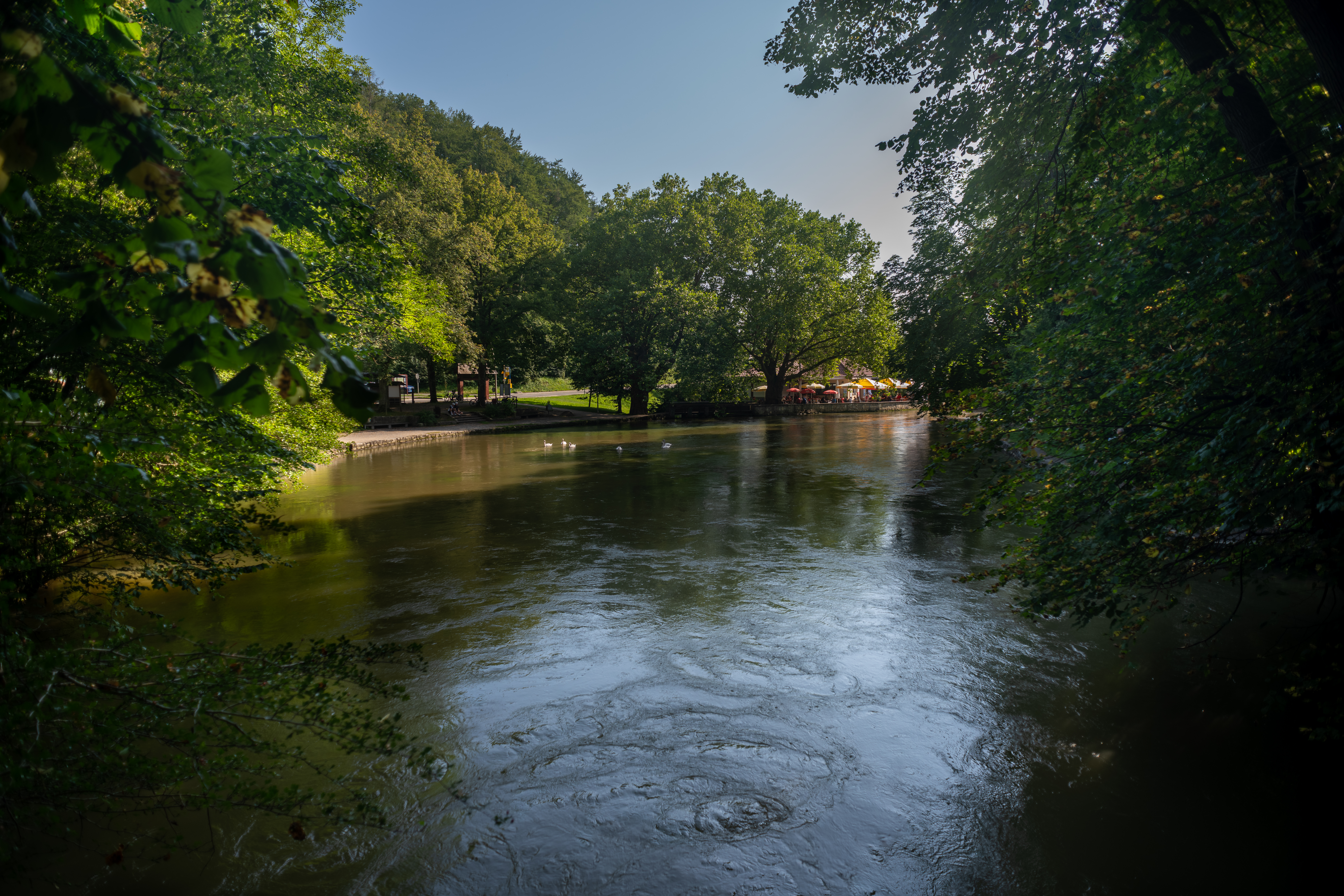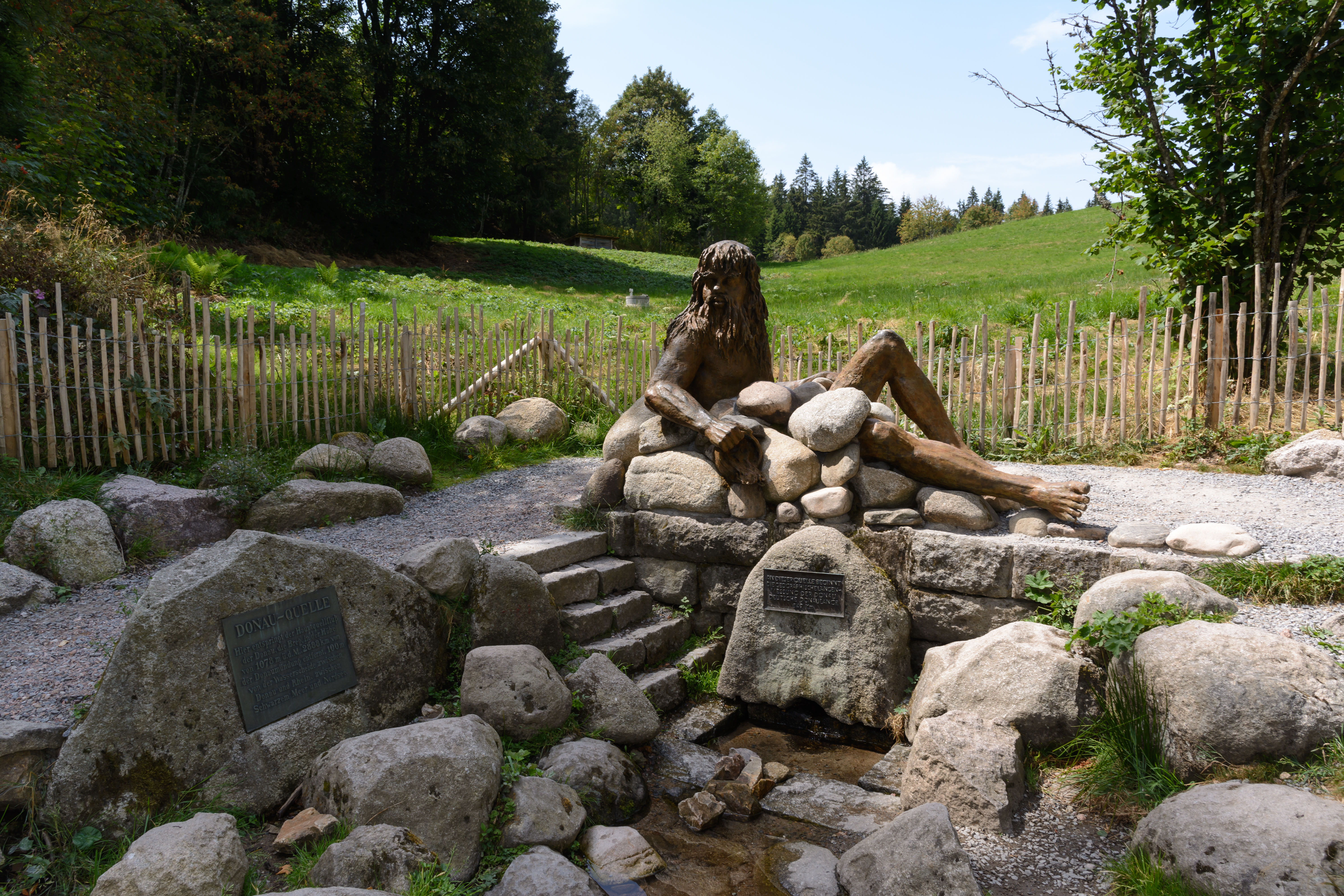|
Aachtopf
The Aachtopf () is Germany's biggest karst spring, south of the western end of the Swabian Jura near the town of Aach. It produces an average of 8,500 litres per second. Most of the water stems from the River Danube where it disappears underground at the Danube Sinkhole, north near Immendingen and about north near Fridingen. The cave system has been explored since the 1960s, but as of 2020 only a small part has been discovered due to a large blockage after a few hundred metres. Etymology The name Aachtopf is compounded from ''Aach'' (meaning "water" in Old High German); ''Topf'' can be translated as "bowl" and is commonly used for round, bowl-shaped springs. Geography The Aachtopf is a karst spring, south of the western end of the Swabian Jura near the town of Aach. The spring is the source of the river Radolfzeller Aach, which flows southward into Lake Constance, and empties into the Rhine. Origin The spring marks the southern end of a cave system that transports water ... [...More Info...] [...Related Items...] OR: [Wikipedia] [Google] [Baidu] |
Aachtopf 2056-HDR
The Aachtopf () is Germany's biggest karst spring, south of the western end of the Swabian Jura near the town of Aach. It produces an average of 8,500 litres per second. Most of the water stems from the River Danube where it disappears underground at the Danube Sinkhole, north near Immendingen and about north near Fridingen. The cave system has been explored since the 1960s, but as of 2020 only a small part has been discovered due to a large blockage after a few hundred metres. Etymology The name Aachtopf is compounded from ''Aach'' (meaning "water" in Old High German); ''Topf'' can be translated as "bowl" and is commonly used for round, bowl-shaped springs. Geography The Aachtopf is a karst spring, south of the western end of the Swabian Jura near the town of Aach. The spring is the source of the river Radolfzeller Aach, which flows southward into Lake Constance, and empties into the Rhine. Origin The spring marks the southern end of a cave system that transports water fr ... [...More Info...] [...Related Items...] OR: [Wikipedia] [Google] [Baidu] |
Danube Sinkhole
Sinkhole in the Danube near Möhringen Schematic of the sinkhole locations and the route to Aachtopf Completely dry Danube riverbed right , Sink hole on the southern bank of the Danube, at the main sinkhole site below Immendingen Sign in Immendingen. Translation: "Sinkhole – Here the Danube sinks dry on about 155 days per year" The Danube Sinkhole (german: Donauversinkung or ) is an incipient underground stream capture in the Upper Danube Nature Park. Between Immendingen and Möhringen and also near Fridingen (Tuttlingen), the water of the Danube sinks into the riverbed in various places. The main sinkhole is next to a field named ''Brühl'' between Immendingen and Möhringen. The term "sinking" is more accurate than "seeping", because, instead of just distributing into the soil, the Danube's water flows through caverns to the Aachtopf, where it emerges as the river Radolfzeller Aach, a tributary of the Rhine. Hydrography The sinking Danube water disappears int ... [...More Info...] [...Related Items...] OR: [Wikipedia] [Google] [Baidu] |
Radolfzeller Aach
The Radolfzeller Aach (also known as Hegauer Aach) is a right or north tributary of the Rhine in the south of Baden-Württemberg (Germany). It is approximately 32 km long. Course The source of the river is the ''Aachtopf'' in Aach, the largest spring in Germany, at a height of 475 m above sea level. The water emerges from a karst cave. About two thirds of the water originates in the headwaters of the Danube. Between Immendingen and Möhringen an der Donau and in Fridingen, water from the Danube disappears underground (this is known as the ''Danube Sinkhole''); this water reappears in the Aachtopf. The river first flows through a number of nature reserves in the Hegau area. This segment of the river is known as ''Hegauer Aach''. It then flows South to Singen, where it is known as ''Radolfzeller Aach''. The last six kilometers of the lower course flow through a nature reserve called ''Radolfzeller Aach Ried''. It flows into the northwestern part of Lake Untersee ... [...More Info...] [...Related Items...] OR: [Wikipedia] [Google] [Baidu] |
Aach, Baden-Württemberg
Aach () is a small town in the German state of Baden-Württemberg (the region of Hegau). Being situated close to Lake Constance and the Swiss border, it is mostly known for the Aachtopf — Germany's biggest natural spring in terms of production. The town was originally twinned with the region of Colmnitz, but following the integration of Colmnitz into Klingenberg, Saxony the town is now twinned with Klingenberg itself. History Aach was first mentioned in the year 1100, as part of the Duchy of Swabia. By the year 1150 the settlement was known in Latin as '. In 1200, the lords transferred ownershp of the town to the Prince-Bishopric of Constance. Aach was granted town rights in 1283 by King Rudolph I of Germany. For the next centuries it was a part of Further Austria until the House of Habsburg purchased the County of Nellenburg, the county in which Aach was situated. In 1499 battles of the Swabian War took place right before gates of Aach. Only 26 years later, in 1525, the Germ ... [...More Info...] [...Related Items...] OR: [Wikipedia] [Google] [Baidu] |
Stream Capture
Stream capture, river capture, river piracy or stream piracy is a geomorphological phenomenon occurring when a stream or river drainage system or watershed is diverted from its own bed, and flows instead down the bed of a neighbouring stream. This can happen for several reasons, including: *Tectonic earth movements, where the slope of the land changes, and the stream is tipped out of its former course *Natural damming, such as by a landslide or ice sheet *Erosion, either **Headward erosion of one stream valley upwards into another, or **Lateral erosion of a meander through the higher ground dividing the adjacent streams. **Within an area of karst topography, where streams may ''sink'', or flow underground (a sinking or losing stream) and then reappear in a nearby stream valley *Glacier retreat The additional water flowing down the capturing stream may accelerate erosion and encourage the development of a canyon (gorge). The now-dry valley of the original stream is known as a ... [...More Info...] [...Related Items...] OR: [Wikipedia] [Google] [Baidu] |
Danube
The Danube ( ; ) is a river that was once a long-standing frontier of the Roman Empire and today connects 10 European countries, running through their territories or being a border. Originating in Germany, the Danube flows southeast for , passing through or bordering Austria, Slovakia, Hungary, Croatia, Serbia, Romania, Bulgaria, Moldova, and Ukraine before draining into the Black Sea. Its drainage basin extends into nine more countries. The largest cities on the river are Vienna, Budapest, Belgrade and Bratislava, all of which are the capitals of their respective countries; the Danube passes through four capital cities, more than any other river in the world. Five more capital cities lie in the Danube's basin: Bucharest, Sofia, Zagreb, Ljubljana and Sarajevo. The fourth-largest city in its basin is Munich, the capital of Bavaria, standing on the Isar River. The Danube is the second-longest river in Europe, after the Volga in Russia. It flows through much of Central and Sou ... [...More Info...] [...Related Items...] OR: [Wikipedia] [Google] [Baidu] |
Karst Spring
A karst spring or karstic spring is a spring (outflow of groundwater) that is part of a karst hydrological system. Description Because of their often conical or inverted bowl shape, karst springs are also known in German-speaking lands as a ''Topf'' ("pot") which is reflected in names such as Aachtopf (the source of the Radolfzeller Aach) or Blautopf (the source of the Blau river in Blaubeuren). Karst springs often have a very high yield or discharge rate, because they are often fed by underground drainage from a large catchment basin. Because the springs are usually the terminus of a cave drainage system at the place where a river cave reaches the Earth's surface, it is often possible to enter the caves from karst springs for exploration. Large karst springs are located in many parts of the world; the largest ones are believed to be in Papua New Guinea, with others located in Mediterranean countries such as Bosnia and Herzegovina, Croatia, Turkey, Slovenia, and Italy. Types ... [...More Info...] [...Related Items...] OR: [Wikipedia] [Google] [Baidu] |
Swabian Jura
The Swabian Jura (german: Schwäbische Alb , more rarely ), sometimes also named Swabian Alps in English, is a mountain range in Baden-Württemberg, Germany, extending from southwest to northeast and in width. It is named after the region of Swabia. The Swabian Jura occupies the region bounded by the Danube in the southeast and the upper Neckar in the northwest. In the southwest it rises to the higher mountains of the Black Forest. The highest mountain of the region is the Lemberg (). The area's profile resembles a high plateau, which slowly falls away to the southeast. The northwestern edge is a steep escarpment (called the Albtrauf or Albanstieg, rising up , covered with forests), while the top is flat or gently rolling. In economic and cultural terms, the Swabian Jura includes regions just around the mountain range. It is a popular recreation area. Geology The geology of the Swabian Jura is mostly limestone, which formed the seabed during the Jurassic period. The sea r ... [...More Info...] [...Related Items...] OR: [Wikipedia] [Google] [Baidu] |
River Danube
The Danube ( ; ) is a river that was once a long-standing frontier of the Roman Empire and today connects 10 European countries, running through their territories or being a border. Originating in Germany, the Danube flows southeast for , passing through or bordering Austria, Slovakia, Hungary, Croatia, Serbia, Romania, Bulgaria, Moldova, and Ukraine before draining into the Black Sea. Its drainage basin extends into nine more countries. The largest cities on the river are Vienna, Budapest, Belgrade and Bratislava, all of which are the capitals of their respective countries; the Danube passes through four capital cities, more than any other river in the world. Five more capital cities lie in the Danube's basin: Bucharest, Sofia, Zagreb, Ljubljana and Sarajevo. The fourth-largest city in its basin is Munich, the capital of Bavaria, standing on the Isar River. The Danube is the second-longest river in Europe, after the Volga in Russia. It flows through much of Central and Sou ... [...More Info...] [...Related Items...] OR: [Wikipedia] [Google] [Baidu] |
Barbatula
''Barbatula'' is a genus of fish in the family Nemacheilidae native to Europe and Asia.Kottelat, M. (2012)Conspectus cobitidum: an inventory of the loaches of the world (Teleostei: Cypriniformes: Cobitoidei). ''Raffles Bulletin of Zoology, Suppl. No. 26: 1-199.'' They are found in streams, rivers and lakes, and the genus also includes Europe's only cavefish, which only was discovered in the Danube–Aachtopf system in Germany in 2015. ''Barbatula'' formerly included many more species, but these have been moved to other genera, notably ''Oxynoemacheilus''. Species There are currently 19 recognized species in this genus: * ''Barbatula altayensis'' S. Q. Zhu, 1992 * ''Barbatula barbatula'' (Linnaeus, 1758) * ''Barbatula cobdonensis'' ( Gundrizer, 1973) * ''Barbatula conilobus'' Prokofiev, 2016 * ''Barbatula dgebuadzei'' (Prokofiev, 2003) * ''Barbatula dsapchynensis'' Prokofiev, 2016 * ''Barbatula golubtsovi'' (Prokofiev, 2003) * ''Barbatula markakulensis'' ( Men'shikov, 1939) * ' ... [...More Info...] [...Related Items...] OR: [Wikipedia] [Google] [Baidu] |
Jochen Hasenmayer
Jochen Hasenmayer (born 28 October 1941 in Pforzheim, Germany) is a German speleologist and cave diver from Birkenfeld in Baden-Württemberg, whose spectacular dives have frequently made headlines. Cave diving Hasenmayer began his cave diving career in 1957 at the age of fifteen, exploring the Falkensteiner Höhle near Stuttgart. Beginning in the 1960s, Hasenmayer explored many karst springs and caves in the Swabian Jura and elsewhere in Southern Germany, including the Wimsener Höhle, the Aachtopf and the Blautopf. He became famous in 1985 due to the discovery of the ''Mörikedom'' ("Mörike Cathedral", named after the German pastor and poet Eduard Mörike), the second big air-filled chamber in the Blauhöhle, about into the cave system. Some of his terminuses (farthest point reached in a cave) have not been exceeded. In the late 1970s, Hasenmayer was among the divers who searched for an underwater connection between Kingsdale Master Cave and Keld Head in the Yorkshire Dales ... [...More Info...] [...Related Items...] OR: [Wikipedia] [Google] [Baidu] |
Sodium Fluorescein
Fluorescein is an organic compound and dye based on the xanthene tricyclic structural motif, formally belonging to triarylmethine dyes family. It is available as a dark orange/red powder slightly soluble in water and alcohol. It is widely used as a fluorescent tracer for many applications. The color of its aqueous solutions is green by reflection and orange by transmission (its spectral properties are dependent on pH of the solution), as can be noticed in bubble levels, for example, in which fluorescein is added as a colorant to the alcohol filling the tube in order to increase the visibility of the air bubble contained within (thus enhancing the precision of the instrument). More concentrated solutions of fluorescein can even appear red (because under these conditions nearly all incident emission is re-absorbed by the solution). It is on the World Health Organization's List of Essential Medicines. Uses Fluorescein sodium, the sodium salt of fluorescein, is used extensi ... [...More Info...] [...Related Items...] OR: [Wikipedia] [Google] [Baidu] |






